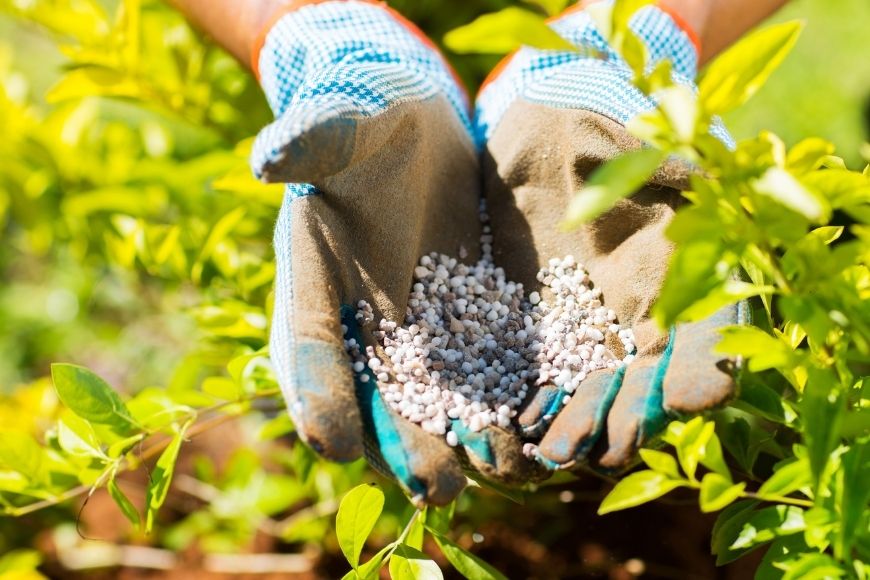
If you are new to growing plants and gardening, the subject of fertilizers can feel rather daunting. You may have glanced at different products and thought, “Chemicals… Eeeek!”
But using fertilizers to grow strong, healthy plants doesn’t need to be scary. With a little knowledge, you can confidently pick out the right fertilizer for your needs.
Where Should You Begin?
If you are just starting a garden for the first time, you might want to have your soil tested. Knowing the pH of the soil is helpful because the pH affects how well plants will grow and what plants will grow well in your dirt.
You will also want to know what nutrients your soil is missing so that you can add what is lacking!
What Exactly Is Fertilizer?
Fertilizer is a product that helps your plants to grow and remain healthy! Some fertilizers will have numbers on the label, such as “10-10-10.” These numbers will tell you how much nitrogen, phosphorus, and potassium the fertilizer contains.
Here are some major nutrients needed by plants:
- Nitrogen promotes the growth of the leaves.
- Phosphorus helps with the production of flowers and fruit.
- Potassium gives your plants a strong root system.
Micronutrients needed by plants:
- Calcium
- Magnesium
- Sulfur
- Boron
- Magnesium
- Manganese
Types of Fertilizers
Organic and Inorganic
There are two basic types of fertilizer--organic and inorganic. Basically, inorganic is made from chemicals while organic fertilizer is made from plants, animal by-products, and naturally occurring minerals.
Organic fertilizers are very eco-friendly. Because they come from natural sources, their production is better for the environment. Many people also prefer to know the products they’re applying to your fruits, veggies, and soil came from natural sources.
Organic fertilizers are made from nutrient-rich ingredients that have not been chemically altered. These naturally nourish your plants and the soil. It will also add microorganisms to your soil and help improve it over time.
Some common organic fertilizer ingredients are:
- Cottonseed meal
- Fish emulsion
- Bone meal
- Blood meal
- Liquid seaweed
- Worm castings
Inorganic fertilizers are the number-one polluting source for groundwater. Furthermore, organic fertilizers make use of byproducts and resources that otherwise would not have a use and wind up in a landfill.
Extended-Release vs. Immediate Release
Fertilizers can also be immediate release or extended-release. They come in granular, powder, and stick. Some of the granular and all of the sticks are slow-released, so they are a good choice if you want a steady supply of nutrients released.
Carefully read the product’s instructions and follow them closely.
Unless specified, fertilizers release their nutrients quickly. So, if you over-apply, it could damage your plants!
Liquid vs. Solid
What do you need to know when choosing between solid and liquid fertilizers? It is easier to handle and store solid fertilizers.
However, be sure to store them out of reach of your pets and children. While not extremely toxic, some precautions could save a trip to the hospital or veterinarian.
Liquid fertilizer can be a very good choice because plants can absorb more nutrients through their leaves than they can through their root system alone.
If you need to mix the solution, make sure that you follow the instructions carefully, then either dispose of the remainder in an environmentally safe way or store it safely, away from pets and children.
Natural DIY Fertilizers
You can even make your own fertilizer with some time and materials from your yard! Here are the most common ways to create fertilizer from around your home:
- Collect the clippings when you cut the grass and compost them.
- Add leaves in the fall to your compost bin.
- Save scraps from cooking and meals, and toss them in with your compost.
- Look for sources for manure, it can be spaded into the soil or added to your compost.
- Make your own earthworm tea to spray on your plants.
These DIY fertilizers do tend to be bulky and their composition can vary. As they break down, they slowly release their nutrients into the soil so your plants will get a continuous supply and they will not burn your plants.
They will also improve the composition of your soil and supply a wide variety of micronutrients.
Using Fertilizers 101
When it comes to applying fertilizers, it’s not complicated. Make sure you read the instructions and follow them carefully.
Applying fertilizer in the morning or evening can help your plant more easily take in the nutrients since they tend to pull water from the soil first thing in the morning.
All plants aren’t fertilized equally. Look up the needs of your plants to see what they need. Some plants like corn, cucumbers, melons, and tomatoes need a lot of fertilizer.
Others like beets, carrots, okra, and potatoes need a moderate amount. And beans, mustard greens, peas, and turnips need less.
If you’re unsure of a plant’s needs, always err on the side of “less is more.” You don’t want to spend days and weeks planting and nurturing your plants, only to burn them by over-applying the fertilizer!
Fertilizing your flowers, trees, and garden does not need to be difficult!
A little analysis of your soil and research on your plants will give you an overview of what you need. Then decide what type of fertilizers you prefer. Carefully apply fertilizers to your plants. Soon you will be enjoying beautiful blossoms and delicious veggies, knowing that you did it all yourself.
Happy planting!
